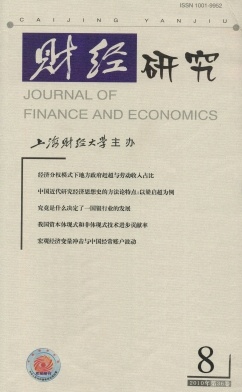我国资本体现式和非体现式技术进步贡献率——来自纺织业的经验证据
财经研究 2010 年 第 36 卷第 08 期, 页码:79 - 90
摘要
参考文献
摘要
文章采用修正的C-M方法,通过构建纺织业资本指数KI和资本体现式技术进步指数KETI,测算融合在纺织业资本积累中的技术进步,并利用隐性变量法估算出非体现式技术进步进行对比。结果显示,我国纺织业资本增长30.31%源于资本体现式技术进步,资本对纺织业产出贡献率为51.83%,劳动力贡献率为31.69%,资本体现式技术进步贡献率为15.71%,是非体现式技术进步贡献的5.1倍,技术进步综合贡献率为18.79%。这表明纺织业生产率增长主要源于资本体现式技术进步,证明了我国高资本积累中蕴含高技术进步的事实。
[1]郭庆旺,贾俊雪.中国全要素生产率的估算:1978-2004[J].经济研究,2005,(6):51-60.
[2]黄先海,刘毅群.物化性技术进步与我国工业生产率增长[J].数量经济技术经济研究,2006,(4):52-60.
[3]黄先海,刘毅群.设备投资、体现型技术进步与生产率增长[J].世界经济,2008,(4):47-61.
[4]赵志耘,吕冰洋,郭庆旺,贾俊雪.资本积累与技术进步的动态融合[J].经济研究,2007,(11):18-31.
[5]郑京海,胡鞍钢.中国改革时期省际生产率增长变化的实证分析(1979~2001)[J].经济学,2005,(2):263-296.
[6]郑玉歆.理解全要素生产率:用TFP分析经济增长质量存在的若干局限[R].清华大学生产率研究专题研讨会,工作论文,2007.
[7]王小鲁,樊纲.中国地区差距的变动趋势和影响因素[J].经济研究,2004,(1):33-44.
[8]Chen E K Y.The total factor productivity debate:Determinants of economic growthinEast Asia[J].Asian-Pacific Economic Literature,1997,11(1):18-70.
[9]Felipe J.Total factor productivity growthin East Asia:Acritical survey[J].The Jour-nal of Development Studies,1999,35(4):1-41.
[10]Gordon RJ.The measurement of durable goods princes[M].Chicago:University ofChicago Press,1990.
[11]Gordon R J.Technology and economic performance in the American economy[R].NBER Working Paper,No.w.8771,2002.
[12]Greenwood J,A Seshadri.The U.S.demographic transition[J].Federal ReserveBank of Cleveland,Working Paper No.w.0118,2001:1-21.
[13]Isaksson A.Productivity and aggregate growth:A global picture[J].UNIDO Work-ing Paper,2007:1-56.
[14]Jorgenson D W,L Frank.Industry-level productivity and international competitive-ness between Canada and the United States[J].The American Economic Review,2000,(5):161-167.
[15]Jorgenson D W.Information technology and the G7 economies[J].World Economics,2003,4(4):139-170.
[16]Otsuka K,G Ranis,and G Saxonhouse.Comparative technology choice in develop-ment—The Indian and Japanese cotton textile industries[M].The Mac Millan Press,London,1988:3-109.
[17]Pack H.Productivity,Technology andindustrial development[M].Oxford UniversityPress,1987:1-54.
[18]Pakko M R.Invest ment-specific technology growth:Concepts and recent esti mates[R].The Federal Reserve Bank of St.Louis Working Paper,2002a,3-16.
[19]Szirmai A,MTi mmer,R Kamp.Measuring embodied technological changeinIndone-sian textiles:The core machinery approach[R].Australian National University,Work-ing Paper,2001,1-18.
[2]黄先海,刘毅群.物化性技术进步与我国工业生产率增长[J].数量经济技术经济研究,2006,(4):52-60.
[3]黄先海,刘毅群.设备投资、体现型技术进步与生产率增长[J].世界经济,2008,(4):47-61.
[4]赵志耘,吕冰洋,郭庆旺,贾俊雪.资本积累与技术进步的动态融合[J].经济研究,2007,(11):18-31.
[5]郑京海,胡鞍钢.中国改革时期省际生产率增长变化的实证分析(1979~2001)[J].经济学,2005,(2):263-296.
[6]郑玉歆.理解全要素生产率:用TFP分析经济增长质量存在的若干局限[R].清华大学生产率研究专题研讨会,工作论文,2007.
[7]王小鲁,樊纲.中国地区差距的变动趋势和影响因素[J].经济研究,2004,(1):33-44.
[8]Chen E K Y.The total factor productivity debate:Determinants of economic growthinEast Asia[J].Asian-Pacific Economic Literature,1997,11(1):18-70.
[9]Felipe J.Total factor productivity growthin East Asia:Acritical survey[J].The Jour-nal of Development Studies,1999,35(4):1-41.
[10]Gordon RJ.The measurement of durable goods princes[M].Chicago:University ofChicago Press,1990.
[11]Gordon R J.Technology and economic performance in the American economy[R].NBER Working Paper,No.w.8771,2002.
[12]Greenwood J,A Seshadri.The U.S.demographic transition[J].Federal ReserveBank of Cleveland,Working Paper No.w.0118,2001:1-21.
[13]Isaksson A.Productivity and aggregate growth:A global picture[J].UNIDO Work-ing Paper,2007:1-56.
[14]Jorgenson D W,L Frank.Industry-level productivity and international competitive-ness between Canada and the United States[J].The American Economic Review,2000,(5):161-167.
[15]Jorgenson D W.Information technology and the G7 economies[J].World Economics,2003,4(4):139-170.
[16]Otsuka K,G Ranis,and G Saxonhouse.Comparative technology choice in develop-ment—The Indian and Japanese cotton textile industries[M].The Mac Millan Press,London,1988:3-109.
[17]Pack H.Productivity,Technology andindustrial development[M].Oxford UniversityPress,1987:1-54.
[18]Pakko M R.Invest ment-specific technology growth:Concepts and recent esti mates[R].The Federal Reserve Bank of St.Louis Working Paper,2002a,3-16.
[19]Szirmai A,MTi mmer,R Kamp.Measuring embodied technological changeinIndone-sian textiles:The core machinery approach[R].Australian National University,Work-ing Paper,2001,1-18.
引用本文
王林辉, 董直庆. 我国资本体现式和非体现式技术进步贡献率——来自纺织业的经验证据[J]. 财经研究, 2010, 36(8): 79–90.
导出参考文献,格式为:





 5359
5359  2828
2828

